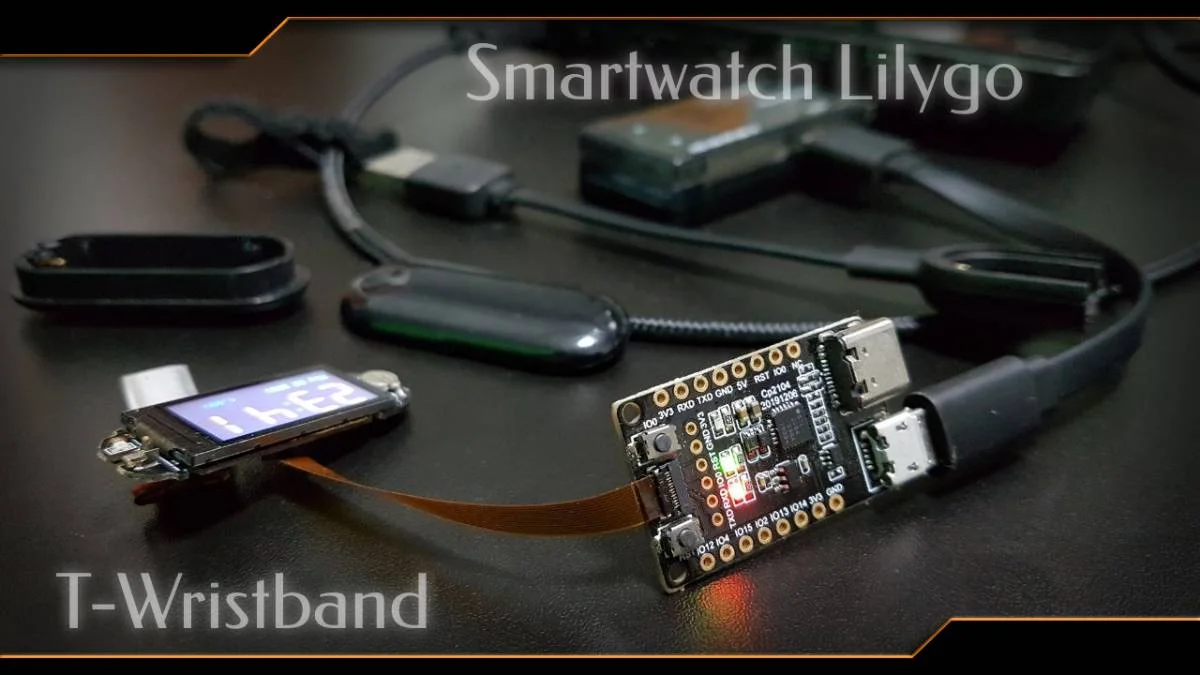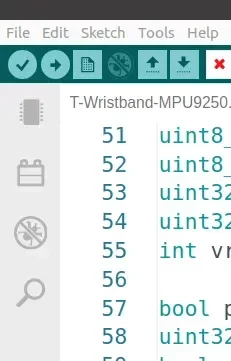Manual
do
Maker
.
com
Pulseira com ESP32

A imagem de destaque é a T-Wristband na placa de gravação. Essa pulseira com esp32 não é exatamente uma novidade, já escrevi sobre ele há algum tempo, mas na época o repositório padrão sugerido pelo fabricante não colocava o relógio pra funcionar adequadamente, provavelmente pelas variações de versões das bibliotecas. Agora está fácil e vou aproveitar pra programar algo diferente. Acompanhe o artigo!
Smartwatch ou pulseira com esp32 com ESP32?
Chamá-lo apenas de "pulseira" é subestimar o produto. Ele possui giroscópio, acelerômetro e magnetômetro funcionais, além de um RTC para a data/hora. Também mostra a tensão, além do (óbvio) display e sensor de toque capacitivo. É um espetáculo de hardware, extremamente compacto. Sua bateria é de 80mAh, daí você pode pensar: "Um ESP32 rodando com WiFi e bluetooth com uma bateria de 80mAh?" - mas calma. Deixando-o absolutamente em deep sleep, sua bateria dura quase 27 horas. Considerando que vamos utilizá-lo algumas vezes ao dia, sua carga é suficiente para 24 horas, mas se precisar de um uso mais intenso, deve dar tempo de chegar a algum lugar que tenha uma porta USB para carregá-lo. Vale citar a série sobre os modos de sleep do ESP32, onde escrevi 4 ou 5 artigos. Em deep sleep o consumo é de aproximadamente 3mA.
Setup inicial
A única parte que dá trabalho é o setup inicial, já que não basta instalar uma biblioteca. Então, vamos fazer de uma maneira bem simples.
Na IDE do Arduino, selecione a placa ESP32 Dev Module. Se ainda não tem o repositório para ESP32 na sua IDE, vá em Arquivos > Preferências e adicione essa URL no Board Manager:
https://dl.espressif.com/dl/package_esp32_index.json
Se já tiver alguma, basta separar com vírgula.
Estou usando a IDE 2.0, que ainda é beta, mas funciona bem. No vídeo dá pra ver os passos nessa nova IDE.
Feito isso, vá em Boards Manager (é o primeiro ícone da esquerda) e digite ESP32. Instale o suporte.

Repositório oficial da Lilygo T-Wristband
Agora baixe o arquivo zip ou clone o repositório que dará suporte a todo o hardware da placa. Copie tudo que está dentro do diretório libdeps para o diretório Arduino/libraries. Fiz um fork do repositório para garantir uma versão funcional permanente, caso esteja se guiando por esse artigo em qualquer momento de sua vida.
Abra um dos exemplos e compile para ver que tipo de erros pode dar. Obtive alguns erros compilando no Linux, no vídeo mostro como resolvê-los.
Assim que conseguir compilar sem problemas, basta fazer o upload. A conexão da placa de desenvolvimento é simples, só encaixar o flat cable no ESP32 e fechar o slot. Também mostro no vídeo.
Precisa desmontar toda a vez que for gravar?
Desmontar algumas vezes pode até ser legal, mas imagine estar definindo um firmware para ela, removendo bugs até chegar no "estado-da-arte". Seria um incômodo, certamente. Porém, basta gravar um firmware com suporte a OTA e considerando que não cometerá um erro que faça o dispositivo ficar reiniciando, ficará fácil gravar um novo firmware! E se cometer alguma falha grave no desenvolvimento, sem problemas também; basta desmontar e conectar o dispositivo à placa de gravação.
Projeto: Trocador de slides
Uma aplicação interessante seria um trocador de slides. Imagine estar dando uma palestra; Deixe o laptop como hot spot e tire o ESP32 de deep sleep; 1 toque adianta o slide, 2 toque volta o slide. Com isso, não precisamos sair de foco para clicar em slides, nem pedir para alguém avançar para o próximo. Segurando o touch por 3 segundos, entraremos em deep sleep novamente. Bora pro código.
Lembre-se: Siga o processo descrito e abra um sketch de exemplo, ele trará todas as dependências sem precisar se preocupar com mais nada. Salve esse sketch com outro nome e substitua o código por esse:
#include <pcf8563.h>
#include <TFT_eSPI.h> // Graphics and font library for ST7735 driver chip
#include <SPI.h>
#include <Wire.h>
#include <WiFi.h>
#include "sensor.h"
#include "esp_adc_cal.h"
#include "ttgo.h"
#include "charge.h"
#include "credentials.h"
#define TP_PIN_PIN 33
#define I2C_SDA_PIN 21
#define I2C_SCL_PIN 22
#define IMU_INT_PIN 38
#define RTC_INT_PIN 34
#define BATT_ADC_PIN 35
#define VBUS_PIN 36
#define TP_PWR_PIN 25
#define LED_PIN 4
#define CHARGE_PIN 32
extern MPU9250 IMU;
TFT_eSPI tft = TFT_eSPI(); // Invoke library, pins defined in User_Setup.h
PCF8563_Class rtc;
char buff[256];
bool rtcIrq = false;
bool initial = 1;
bool otaStart = false;
uint8_t func_select = 0;
uint8_t omm = 99;
uint8_t xcolon = 0;
uint32_t targetTime = 0; // for next 1 second timeout
uint32_t colour = 0;
int vref = 1100;
bool doit = true;
bool pressed = false;
uint32_t pressedTime = 0;
bool charge_indication = false;
unsigned long int pressed_time = 0;
uint8_t count = 0;
uint8_t hh, mm, ss ;
void go_down(){
tft.setTextColor(TFT_GREEN, TFT_BLACK);
tft.setTextDatum(MC_DATUM);
tft.drawString("Press again to wake up", tft.width() / 2, tft.height() / 2 );
IMU.setSleepEnabled(true);
Serial.println("Go to Sleep");
delay(3000);
tft.writecommand(ST7735_SLPIN);
tft.writecommand(ST7735_DISPOFF);
esp_sleep_enable_ext1_wakeup(GPIO_SEL_33, ESP_EXT1_WAKEUP_ANY_HIGH);
esp_deep_sleep_start();
}
void touchMonitor(void *pvParameters){
while (true){
pressed_time = millis();
uint8_t tp_state = digitalRead(TP_PIN_PIN);
doit = tp_state > 0 ? true : false;
if (doit){
while (digitalRead(TP_PIN_PIN)){
vTaskDelay(pdMS_TO_TICKS(10));
}
if ((millis()-pressed_time) < 1000){
Serial.println("MENOR QUE 1s");
}
else if ((millis()-pressed_time) > 1000 && (millis()-pressed_time) < 3000) {
Serial.println("MAIOR QUE 1s");
}
else if ((millis()-pressed_time) > 3000){
go_down();
}
}
vTaskDelay(pdMS_TO_TICKS(10));
}
}
void shortTouchMonitor(void *pvParameters){
unsigned long int taps = millis();
int time_limit = 3000;
while (true){
//contador
if (digitalRead(TP_PIN_PIN) && (millis()-taps) < time_limit){
count += 1;
vTaskDelay(pdMS_TO_TICKS(200));
}
//validador: se for 1 e não tiver mais toque e já deu timeout...
if (count == 1 && !digitalRead(TP_PIN_PIN) && (millis()-taps) > time_limit){
Serial.println("Next");
taps = millis();
count = 0;
}
//senão, se 2 e não tiver mais toque e já deu timeout...
else if (count == 2 && !digitalRead(TP_PIN_PIN) && (millis()-taps) > time_limit){
Serial.println("Previous");
taps = millis();
count = 0;
}
//se não teve toque e excedeu o tempo...
else if ((millis()-taps) > time_limit && count == 0){
taps = millis();
vTaskDelay(pdMS_TO_TICKS(200));
}
}
vTaskDelay(pdMS_TO_TICKS(10));
}
void scanI2Cdevice(void)
{
uint8_t err, addr;
int nDevices = 0;
for (addr = 1; addr < 127; addr++) {
Wire.beginTransmission(addr);
err = Wire.endTransmission();
if (err == 0) {
Serial.print("I2C device found at address 0x");
if (addr < 16)
Serial.print("0");
Serial.print(addr, HEX);
Serial.println(" !");
nDevices++;
} else if (err == 4) {
Serial.print("Unknow error at address 0x");
if (addr < 16)
Serial.print("0");
Serial.println(addr, HEX);
}
}
if (nDevices == 0)
Serial.println("No I2C devices found\n");
else
Serial.println("Done\n");
}
void factoryTest()
{
scanI2Cdevice();
delay(2000);
tft.fillScreen(TFT_BLACK);
tft.drawString("RTC Interrupt self test", 0, 0);
int yy = 2021, mm = 5, dd = 27, h = 3, m = 15, s = 0;
rtc.begin(Wire);
rtc.setDateTime(yy, mm, dd, h, m, s);
delay(500);
RTC_Date dt = rtc.getDateTime();
if (dt.year != yy || dt.month != mm || dt.day != dd || dt.hour != h || dt.minute != m) {
tft.setTextColor(TFT_RED, TFT_BLACK);
tft.fillScreen(TFT_BLACK);
tft.drawString("Write DateTime FAIL", 0, 0);
} else {
tft.setTextColor(TFT_GREEN, TFT_BLACK);
tft.fillScreen(TFT_BLACK);
tft.drawString("Write DateTime PASS", 0, 0);
}
}
void setupADC()
{
esp_adc_cal_characteristics_t adc_chars;
esp_adc_cal_value_t val_type = esp_adc_cal_characterize((adc_unit_t)ADC_UNIT_1, (adc_atten_t)ADC1_CHANNEL_6, (adc_bits_width_t)ADC_WIDTH_BIT_12, 1100, &adc_chars);
//Check type of calibration value used to characterize ADC
if (val_type == ESP_ADC_CAL_VAL_EFUSE_VREF) {
Serial.printf("eFuse Vref:%u mV", adc_chars.vref);
vref = adc_chars.vref;
} else if (val_type == ESP_ADC_CAL_VAL_EFUSE_TP) {
Serial.printf("Two Point --> coeff_a:%umV coeff_b:%umV\n", adc_chars.coeff_a, adc_chars.coeff_b);
} else {
Serial.println("Default Vref: 1100mV");
}
}
void setupRTC()
{
rtc.begin(Wire);
//Check if the RTC clock matches, if not, use compile time
rtc.check();
RTC_Date datetime = rtc.getDateTime();
hh = datetime.hour;
mm = datetime.minute;
ss = datetime.second;
}
void setupWiFi(){
WiFi.begin(SSID,PASSWD);
for (uint8_t i=0;i<10;i++){
Serial.print(".");
delay(200);
while (WiFi.status() != WL_CONNECTED){
delay(100);
Serial.print(".");
}
Serial.println(WiFi.localIP());
}
}
void setup(void)
{
Serial.begin(115200);
tft.init();
tft.setRotation(1);
tft.setSwapBytes(true);
tft.pushImage(0, 0, 160, 80, ttgo);
Wire.begin(I2C_SDA_PIN, I2C_SCL_PIN);
Wire.setClock(400000);
//factoryTest(); //após ajustar a hora, comentar essa função
setupRTC();
setupMPU9250();
setupADC();
setupWiFi();
tft.fillScreen(TFT_BLACK);
tft.setTextColor(TFT_YELLOW, TFT_BLACK); // Note: the new fonts do not draw the background colour
targetTime = millis() + 1000;
pinMode(TP_PIN_PIN, INPUT);
//! Must be set to pull-up output mode in order to wake up in deep sleep mode
pinMode(TP_PWR_PIN, PULLUP);
digitalWrite(TP_PWR_PIN, HIGH);
pinMode(LED_PIN, OUTPUT);
pinMode(CHARGE_PIN, INPUT_PULLUP);
attachInterrupt(CHARGE_PIN, [] {
charge_indication = true;
}, CHANGE);
if (digitalRead(CHARGE_PIN) == LOW) {
charge_indication = true;
}
//xTaskCreatePinnedToCore(touchMonitor,"touchMonitor", 10000, NULL, 1, NULL,0);
xTaskCreatePinnedToCore(shortTouchMonitor,"shortTtouchMonitor", 10000, NULL, 1, NULL,0);
}
String getVoltage()
{
uint16_t v = analogRead(BATT_ADC_PIN);
float battery_voltage = ((float)v / 4095.0) * 2.0 * 3.3 * (vref / 1000.0);
return String(battery_voltage) + "V";
}
void RTC_Show()
{
if (targetTime < millis()) {
RTC_Date datetime = rtc.getDateTime();
hh = datetime.hour;
mm = datetime.minute;
ss = datetime.second;
// Serial.printf("hh:%d mm:%d ss:%d\n", hh, mm, ss);
targetTime = millis() + 1000;
if (ss == 0 || initial) {
initial = 0;
tft.setTextColor(TFT_GREEN, TFT_BLACK);
tft.setCursor (8, 60);
tft.print(__DATE__); // This uses the standard ADAFruit small font
}
tft.setTextColor(TFT_BLUE, TFT_BLACK);
tft.drawCentreString(getVoltage(), 120, 60, 1); // Next size up font 2
// Update digital time
uint8_t xpos = 6;
uint8_t ypos = 0;
if (omm != mm) { // Only redraw every minute to minimise flicker
// Uncomment ONE of the next 2 lines, using the ghost image demonstrates text overlay as time is drawn over it
tft.setTextColor(0x39C4, TFT_BLACK); // Leave a 7 segment ghost image, comment out next line!
//tft.setTextColor(TFT_BLACK, TFT_BLACK); // Set font colour to black to wipe image
// Font 7 is to show a pseudo 7 segment display.
// Font 7 only contains characters [space] 0 1 2 3 4 5 6 7 8 9 0 : .
tft.drawString("88:88", xpos, ypos, 7); // Overwrite the text to clear it
tft.setTextColor(0xFBE0, TFT_BLACK); // Orange
omm = mm;
if (hh < 10) xpos += tft.drawChar('0', xpos, ypos, 7);
xpos += tft.drawNumber(hh, xpos, ypos, 7);
xcolon = xpos;
xpos += tft.drawChar(':', xpos, ypos, 7);
if (mm < 10) xpos += tft.drawChar('0', xpos, ypos, 7);
tft.drawNumber(mm, xpos, ypos, 7);
}
if (ss % 2) { // Flash the colon
tft.setTextColor(0x39C4, TFT_BLACK);
xpos += tft.drawChar(':', xcolon, ypos, 7);
tft.setTextColor(0xFBE0, TFT_BLACK);
} else {
tft.drawChar(':', xcolon, ypos, 7);
}
}
}
void IMU_Show()
{
tft.setTextColor(TFT_GREEN, TFT_BLACK);
tft.fillScreen(TFT_BLACK);
tft.setTextDatum(TL_DATUM);
readMPU9250();
snprintf(buff, sizeof(buff), "-- ACC GYR MAG");
tft.drawString(buff, 0, 0);
snprintf(buff, sizeof(buff), "x %.2f %.2f %.2f", (int)1000 * IMU.ax, IMU.gx, IMU.mx);
tft.drawString(buff, 0, 16);
snprintf(buff, sizeof(buff), "y %.2f %.2f %.2f", (int)1000 * IMU.ay, IMU.gy, IMU.my);
tft.drawString(buff, 0, 32);
snprintf(buff, sizeof(buff), "z %.2f %.2f %.2f", (int)1000 * IMU.az, IMU.gz, IMU.mz);
tft.drawString(buff, 0, 48);
delay(200);
}
void loop(){
if (charge_indication){
charge_indication = false;
if (digitalRead(CHARGE_PIN) == LOW){
tft.pushImage(140, 55, 16, 16, charge);
}
else{
tft.fillRect(140, 55, 16, 16, TFT_BLACK);
}
}
if (digitalRead(TP_PIN_PIN) == HIGH && 3>4){
if (!pressed){
initial = 1;
targetTime = millis() + 1000;
tft.fillScreen(TFT_BLACK);
omm = 99;
func_select = func_select + 1 > 2 ? 0 : func_select + 1;
digitalWrite(LED_PIN, HIGH);
delay(100);
digitalWrite(LED_PIN, LOW);
pressed = true;
pressedTime = millis();
}
else{
if (millis() - pressedTime > 3000){
tft.fillScreen(TFT_BLACK);
tft.drawString("Not used", 20, tft.height() / 2 );
delay(3000);
}
}
}
else{
pressed = false;
}
switch (func_select) {
case 0:
RTC_Show();
break;
case 1:
IMU_Show();
break;
case 2:
tft.setTextColor(TFT_GREEN, TFT_BLACK);
tft.setTextDatum(MC_DATUM);
tft.drawString("Press again to wake up", tft.width() / 2, tft.height() / 2 );
IMU.setSleepEnabled(true);
Serial.println("Go to Sleep");
delay(3000);
tft.writecommand(ST7735_SLPIN);
tft.writecommand(ST7735_DISPOFF);
esp_sleep_enable_ext1_wakeup(GPIO_SEL_33, ESP_EXT1_WAKEUP_ANY_HIGH);
esp_deep_sleep_start();
break;
default:
break;
}
}
Com esse código, um toque em um intervalo de 3 segundos mostrará "Next" na serial e dois toques nesse intervalo mostrará "Previous". No vídeo mostrarei trocando slide e passo o link do repositório, agora vou dar um tapa na comunicação com o laptop para receber o comando.
Mentiria se dissesse que é um bom código; apenas joguei algumas coisas fora e incuti funções quase que sem consentimento, daria até processo se a MCU rodasse uma IA. Mas funciona para o propósito do artigo, que mostrarei no vídeo "smartwatch com esp32" ou "pulseira com esp32" em nosso canal DobitaobyteBrasil no Youtube. Aproveito para agradecer a vocês leitores que tem mostrado claramente seu apoio se inscrevendo no canal. Espero que os vídeos estejam atingindo suas expectativas. Os efeitos especiais não são fundamentais, eu sei, mas ajudam a distrair a mente enquanto pensamos tecnicamente. E convenhamos, minha dicção é uma m****. Quando não estou lendo o texto, parece que estou também, mas o conteúdo é caprichado.
Inscreva-se no nosso canal Manual do Maker no YouTube.
Também estamos no Instagram.

Djames Suhanko
Autor do blog "Do bit Ao Byte / Manual do Maker".
Viciado em embarcados desde 2006.
LinuxUser 158.760, desde 1997.